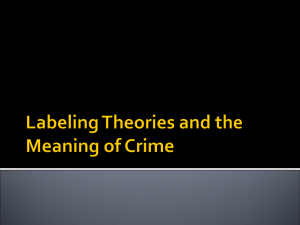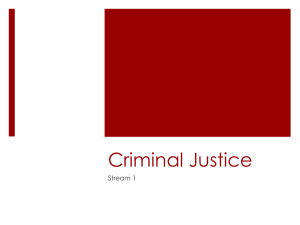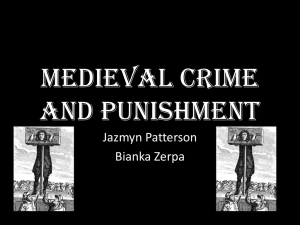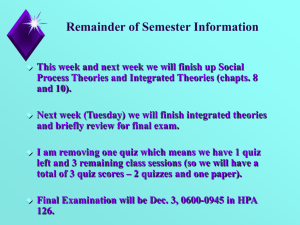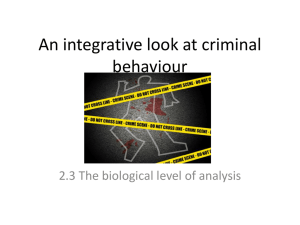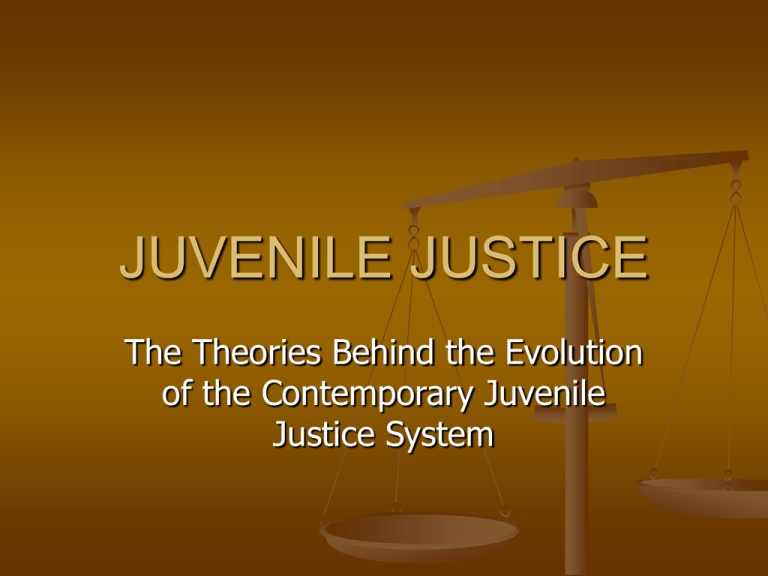
JUVENILE JUSTICE
The Theories Behind the Evolution
of the Contemporary Juvenile
Justice System
WHAT IS JUSTICE?
DISTRIBUTIVE JUSTICE
Also Known as Social Justice
Provides that each person in a society share the
same values, including power, prestige and
possessions (PPP)
Reality: Not all have equal PPP
Merton views crime as a reaction of the poor
who are denied equal access
Underprivileged Youth need more
Focus is on Retribution “Eye for an Eye”
Retributive Justice seeks revenge for unlawful
behavior
RESTORATIVE JUSTICE
Focuses on repairing the harm done to
victims & community by having offenders
contribute to the repair of wrong
Compared to Retributive Justice, which
seeks punishment, Restorative Justice
seeks to restore the needs of victim,
community and offender
Mores and Folkways
Mala in se
Immoral acts such as
murder and rape
Origin in Mores
Rules governing
interaction of people
Natural Law
Common Law
Stable over time
Mala prohibita
Prohibited wrongs
Ex. Public drinking
Origin in Folkways
Governs socially
acceptable behaviors
Man-made laws
Statutory Law
Changes over time
PURPOSES OF LAW
REGULATE HUMAN INTERACTIONS
SUPPORT SOCIAL ORDER
PROTECT THE INTEREST OF SOCIETY
GOVERN BEHAVIOR
DETER ANTISOCIAL BEHAVIOR
ENFORCE MORAL BELIEFS
SUPPORT THOSE IN POWER
UPHOLD INDIVIDUAL RIGHTS
IDENTIFY LAWBREAKERS
PUNISH LAWBREAKERS
SEEK RETRIBUTION FOR WRONGDOING
CONSENSUS THEORY
INDIVIDUALS IN A SOCIETY AGREE ON BASIC
VALUES, ON WHAT IS RIGHT AND WHAT IS
WRONG
LAWS EXPRESS THESE VALUES
EMILE DURKHEIM (French Sociologist)
Punishment is a moral process to preserve shared
values of society
Punishment is a sign that authorities in control
Crime is an aberration (not normal)
Sees punishment as a way to restore and solidify
order
CONSENSUS THEORY
DURKHEIM (Continued)
General population is involved in the act of
punishing, giving it legitimacy
Marked by deeply emotional and passionate
reactions to crime
Anomie: State of normlessness – breakdown
of societal norms, ie. American Dream, Family
Values
CONFLICT THEORY
Rules are established to keep the dominant class in
power.
Rooted in Marx and Engels
Focus on lawmaking and enforcement
Protecting the interests of the dominant groups in
society
Explains the racial disparities in the AJ
Inequalities are the result of dominant White majority
Explains the overrepresentation of racial and ethnic
minorities in arrest, prosecution and imprisonment
Capital punishment results of prejudice
CONFLICT THEORY
Marx sees punishment as a way to control
the lower class and preserve the power of
the upper class
Conservative approach to the juvenile
justice is “get tough on juveniles”
Liberal approach stresses treatment and
rehabilitation
CLASSICAL WORLD VIEW
Humans have free will and are responsible
for their own actions (Cesare Baccaria,
1764 On Crime and Punishment)
Some choose to commit crime
Laws should bring happiness to the
majority
Those who break the law should be
punished according to penalties
established by the law
The focus is on crime
CLASSICAL WORLD VIEW
Society functions under a social contract, with
individuals giving up certain freedoms
Delinquency is a result of freewill
Advocates harsh and immediate punishment
Deterrence: Threat of punishment will deter
crime
Advocates incapacitation as consequence for
criminal behavior
Just Deserts approach
Conflicts with Parens Patriae
POSITIVIST WORLD VIEW
Cesare Lambroso (1835 -1909) Father of
Criminology
Criminals are born with predisposition to
crime
Need favorable conditions to avoid criminality
Primary cause is biological
Started people thinking that there were other
causes to crime besides freewill
POSITIVIST WORLD VIEW
Humans are shaped by their society and
are products of their environmental and
cultural influences.
Individual criminal actions are determined
not by freewill but by biological and
cultural factors
Purpose of law is to advert revolution and
convince masses to accept social order
Focus is on the criminal
POSITIVIST WORLD VIEW
Believe that juvenile delinquency is the result of
the youth’s biological make-up and life
experiences
Advocate community-based treatment to
rehabilitate offenders instead of incarceration
Youth should not be labeled and punished as
criminals
Determinism: Human behavior is the result of
multiple environmental and cultural influences
CAUSES OF CRIME AND
DELINQUENCY
OVERVIEW
BIOLOGICAL THEORIES
Researchers find that some biological
factors are found more frequently in
criminal types than non-criminals
Theories include Physiognomy,
Phrenology, Body Type, and Heredity
Physiognomy Studies
Assigns character traits to physical features,
especially facial features.
Middle Age Law regarded uglier people to be
criminal types
Body Types of Criminals:
Large, predominate crooked noses
Abnormal ears
Lantern jaws
High cheekbones, Large Lips
Higher Sex Drives
Lower intelligences
Large Body Types
Abnormal amounts of body hair
Phrenology
Studies the shape of the skull to predict
intelligence and character
Approached used by Cesare Lombroso in
recognizing anomalies at birth
Anomalies do not cause crime but indicate
a predisposition to crime.
Body Type Theories
Endomophic: soft, fat, easygoing
Mesomorphic: athletic, muscular,
aggressive
Ectomorphic: thin, delicate, shy,
introverted
HEREDITY STUDIES
Twin studies show that identical twins
tend to criminal records together
Twin that has been adopted has a
tendency toward crime more if biological
father had criminal record.
Influenced by genetics and environmental
factors
PSYCHOLOGICAL THEORIES
Focus on intelligence and psychoanalysis
Criminals are morally insane
Do not perceive criminal behavior as wrong
Personality developed in early childhood
Future Behavior determined in early childhood
Later sociological and environmental associations do not
change early behavioral development
Certain personality types have no impulse control
Criminal Families occur over generations
Mental and moral degeneration cause crime
PSYCHOLOGICAL THEORIES
Goddard (1866-1957) Criminals may not be
biologically inferior, but tend to intellecturally
inferior
Sigmund Freud (1859 -1939) Personality
imbalances result from abnormal emotional
development
Problems arise from fixation or regression to the
phallic stage (3 – 6 years)
Unresolved oedipal or electra complex: superego
unable to control the id.
SOOCIOLOGICAL THEORIES
Lack of education
Poverty-level income
Poor Housing
Slum Conditions
Home and Family Conflict Increases Risk for
Crime
Low Achievement Expectations
Continuous Lawbreaking causes individual to
become part of a subculture that advocates
crime and violence as a way to achieve goals or
solve problems
Behavior is learned
ECOLOGICAL MODEL
Robert Park, sociologist, U of Chicago
Compared growth of cities to nature
Several stages of growth
Biotic Balance where relations between different
species of plants and necessary conditions for survival
maintain equilibrium can survive and proper
Have mutual beneficial relationship = symbiosis
What happens when other species of plants enter this
environment?
Social Disorganization Theory
Shaw and McKay, sociologist conducted study on
25,000 youth between 1900-33
Found intecity zones had highest rates of crime
Suggested that social conditions predicted
juvenile delinquency
Gang membership was a normal response to
social conditions
Contended that urban areas produced
delinquency directly by weakening community
controls and generating a subculture of
delinquency passed on from one generation to
another
Social Disorganization Theory
Low economic status
Residential mobility
Ethnic heterogenity
Family Disruption
LEAD TO
Fewer Friendship
Networks
Lower Supervision of
Youth Groups
Lower Organizational
Participation
WHICH LEAD TO
CRIME AND
DELINQUENCY
FUNCTIONALISM
Harvard Sociologist Parsons (1902-1979)
Crime is a natural part of society
Without Crime we would not need laws,
lawyers, police officers, courts, judges,
jails
ANOMIE OR STRAIN THEORY
Building on Parson’s theory, Robert Merton
(1910-2003) saw conflict between cultural goals
of US and our social structure
Borrowed from Durkheim’s concept of anomie
Merton’s premise: Crime does not result from
flaws, failures or free choices of individuals, but
we must consider the sociocultural environments
in which people are located
The American Dream
LEARNING THEORIES
Sutherland and Cressy in Principles of
Criminology
Criminal behavior is learned in interaction with
others
Learning occurs within intimate personal groups
Process of learning occurs by association
Person becomes deliquent because of excess of
definitions that are favorable in breaking laws
LEARNING THEORIES
Differential Association Theory
Explains learning theory and prevention
concepts of positive reinforcement, negative
reinforcement, extinction, punishment, and
modeling or imitation
LABELING THEORY
George Herbert Mead (1863-1931)
Humans act towards things on the basis of
the meanings the things have for them
The meanings of things arises out of social
interaction
Meanings are handled in and modified
through an interpretive process people use to
deal with things they encounter
LABELING THEORY
Primary Deviance = Initial Criminal Act
Secondary Deviance = Accepting the
criminal label and consequently
committing other criminal acts
Juvenile Justice Terminology
vs Adult Criminal Terminology
Adult Court
Arrest
Trial
Conviction
Plea Bargaining
Sentencing
Jail
Incarceration
Prosecutor
Defendant
Probation
Parole
Juvenile Court
Taken into Custody
Adjudicatory Hearing
Adjudication
Adjustment
Disposition
Detention
Commitment
Petitioner
Respondent
Probation
After Care
FUNNEL EFFECT
Describes how fewer and fewer youths are
processed through the JJS
Illustrates the crucial role of law enforcement, schools
and parents in the JJS and process
Example page 65
500 Juvenile arrest to:
354 referred to JC
101 informally handled and released
35 referred to Criminal Court
6 referred to other police Depts.
4 referred to Welfare
FUNNEL EFFECT
Serious Habitual Offender Comprehensive Action
Program
Schools and police are fundamental to control of
delinquency
Except for parents, schools and police have more
contact w/ youth than anyone else
JJS is irrelevant to the prevention and diversion of
delinquency because police are not a significant part
of JJS
Contact and information could be shared between
parents, school and police are key to effectiveness of
JJS
Agencies Coordinated by the
U.S. Dept. of Justice
U. S.
Department of Justice
Office of
Justice programs
Bureau of
Justice Statistics
(BJS)
National Institute
of Justice
(NIJ)
Office of Juvenile
And Delinquency
Prevention
(OJJDP)
National Institute for
Juvenile Justice and
Delinquency Prevention
Office for
Victims of Crime
(OVC)


